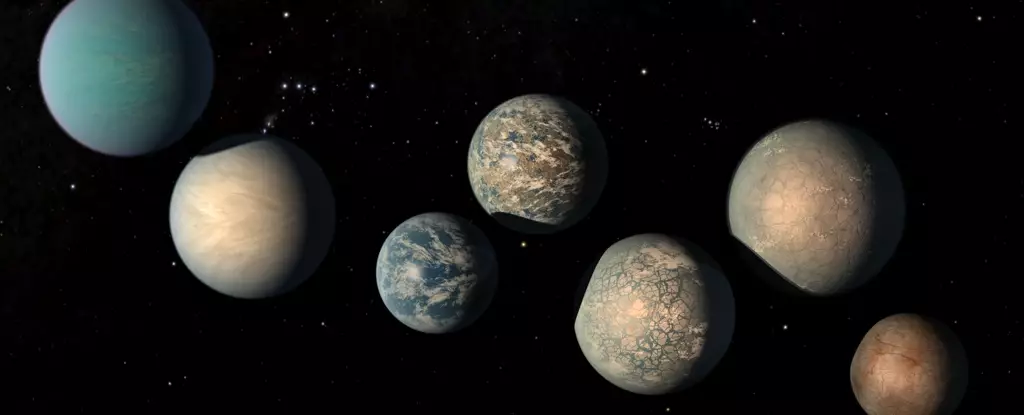The TRAPPIST-1 system has captured the imagination of astronomers and space enthusiasts alike since its discovery in 2017. This unique star system, located approximately 40 light-years away from Earth, is home to seven Earth-sized exoplanets, all orbiting a diminutive red dwarf star. The quest to understand whether these planets are capable of supporting life hinges significantly on the presence of water, a fundamental building block for life as we know it. Recent research has unveiled tantalizing possibilities concerning the water content of these celestial bodies, reigniting debates over their potential habitability.
The Water Factor: A Double-Edged Sword
Water is the essence of life, yet the question surrounding its availability in the TRAPPIST-1 system is complex. Initial enthusiasm has been tempered by concerns regarding the conditions surrounding M-type stars, like TRAPPIST-1. These stars are cooler and smaller than our Sun, but they have a penchant for flaring activity, which could devastate planetary atmospheres. Previous studies have suggested that while these planets might be awash with water, the intense ultraviolet (UV) radiation emitted by their host star may strip this vital resource away into the void of space.
Thus, researchers have grappled with a paradox: do these planets harbor enough water to sustain life, or is it an ephemeral quality subject to the whims of a volatile stellar environment? The latest findings suggest that the surface and atmospheric conditions of these planets warrant deeper investigation.
Debunking the Venusian Myth
Recent observations from the James Webb Space Telescope (JWST) have refined our understanding of TRAPPIST-1 c, one of the system’s more intriguing bodies. Initial assumptions likened it to Venus, primarily due to its size and proximity to its star. However, findings have shown that TRAPPIST-1 c likely does not possess a thick carbon dioxide atmosphere, complicating earlier narratives. This discovery opens up the possibility that water vapor may persist in its atmosphere, driven by volcanic activity and other geological processes.
Astrobiologist Trent Thomas and his research team have emphasized the vital role that volcanic outgassing could play in maintaining atmospheric water. Their model, built on the behavior of rocky planets in our solar system, suggests that the potential for water vapor retention might hinge on ongoing geological activity. However, it appears that the TRAPPIST-1 planets may be lacking in volcanic vigor, which complicates the scenario further.
Magma Movement: The Key to Understanding
Intriguingly, research indicates that the magma movement rates of the TRAPPIST-1 planets are reminiscent of those on Mars—a planet once thought to be alike to Earth but now largely classified as volcanically inactive. The implications are significant. If the TRAPPIST-1 planets share this characteristic lack of volcanic activity, the early enthusiasm over their water abundance may need to be recalibrated.
outgassing estimates suggest that the water released in this manner could be as much as eight times more than that on Earth on a good day but often leans towards lower estimates. Thus the potential for these planets to hold substantial amounts of water—a crucial lifeline for life—is increasingly shrouded in uncertainty.
The Drier Mantle Hypothesis
Research indicates that the mantles of the TRAPPIST-1 planets are likely drier than initially thought, with water making up a mere fraction of their mass. This realization runs contrary to the assumption that they might be ‘water worlds.’ Instead, it seems they could be a blend of barren rocks and slightly more hospitable environments. While a damp mantle might still exist, the preferred hypothesis is that it consists of less than 1 percent water content by weight.
This distinction is vital, as it shapes our understanding of what type of environments are most likely found on these distant worlds. The lower presence of water in the mantles aligns them closer to Mars than Earth, raising concerns about the system’s habitability. Such drier conditions might indicate any potential life forms would face significant challenges in both forming and sustaining themselves on these planets.
Future Possibilities and Probing the Unknown
Despite these discoveries, the TRAPPIST-1 system remains a tantalizing enigma. With ongoing observations from JWST and future missions, scientists are eager to gather more data to better understand these worlds. As research continues to unfold, so too does the potential for clarifying the habitability of these exoplanets.
The layers of understanding surrounding TRAPPIST-1 not only provide insights into one specific system but also allow astronomers to refine their methodologies for assessing exoplanetary habitability. As we probe further into this fascinating star system, the hope is that we might one day find a definitive answer to whether life truly exists beyond our home planet. The search for extraterrestrial life hinges on understanding environments that can foster it, making inquiries into TRAPPIST-1 crucial for our broader cosmic exploration.


Leave a Reply